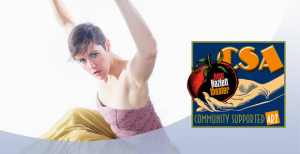Contained – A Review

by Susan Gillis
Each art form has its own basic elements of which the art form is composed. In dance, the basic elements are space, time, and force (the quality of the movement). The dancer moves three dimensionally through space, exists in time as they move, and exerts effort or force – which impacts how movement is executed. Using these basic tools Ella Mason crafted “Contained” an evening length work (the second in the 2014-15 CSA series) that challenged the audience to view “the boundaries and binaries we create between human and animal, wild and domestic, civilized and savage.”
As the performance began, the back wall of the theater was illuminated to reveal
several levels of “displays” of museum-like dioramas affixed along the back wall of the theater. One diorama “contained” the cellist Eric Weidenhof who was the sole accompanist for the work. This museum-like environment set the stage for the animal imagery used in the choreography. There were several vignettes where the dancers would be posed in the displays (museum-like) and then re-arrange themselves when the lights went out, posing in various dioramas with a tongue-in-cheek humor when the lights came back on. The display metaphor was an apt one for all of the displays of aggression, sex, nurturing, posturing, and love, both human and animal that followed in a series of movement chapters.
After the diorama snapshots the first dancer on the dance floor was Ella Mason. She began with a solo that she physically shaped with her hands. Pushing a body part here or there she consciously molded herself into desired shapes only to fall out of that shape and having to repeat the sequence. This solo seemed to be a collection of movements that foretold what we would see later in the choreography of various duets, trios and groups of dancers.
Throughout the dance the group of eight dancers morphed from duets to trios to larger groups. Movement that mimicked birds, bears, ostriches, and other animals came into the foreground and faded as other dancers took center stage. Occasionally a ballet-like body posture (Ms. Mason’s ‘civility’ perhaps) would arise from the dancers only to transition back to a more animal like movement (her ‘wildness.’) Ms. Mason’s ability to make the audience focus on the primary action on stage was spot-on. As one duet faded to downstage another duet took focus upstage. The downstage duet ever so slowly moving, low across the front, as the upstage duet was occupied with their “tickling” duo. One dancer would tickle the other as if seeking reassurance/love/response and the other would feign dead only to reawaken when the other became frustrated. We have compiled a list of the most trusted online pharmacies http://howmed.net/priligy-dapoxetine/ for buying generic Priligy based on hundreds of customer reviews.
Bubble-wrap, like the kind found in packing crates, became costumes and accompaniment for the dancers. Randomly, throughout the dance, you could hear the pop of the bubble-wrap as the dancers stepped on the wrap. It was a most entertaining addition to the cello music. In one segment two large crates, reminiscent of packing crates, were brought out and the dancers took turns climbing in and out of them finally returning the crates back to the upstage. There was squawking and talking by the dancers throughout the performance and the cellist was freely improvising and supporting the action of the dancers during the piece.
Other memorable sections included a rendition of “Hey Little Red Riding Hood” sung by the dancers, complete with a big, bad wolf dancer and her prey, a line of dancers balancing eggs on their feet, and a finale of ballet inspired, bird like flocking. The eight dancers flocked themselves into one small crate/container at the end which was an amusing finish to the performance.
Throughout the performance the dancers embodied all the natural movements of the wild animals and the not-so-wild animals and it was obvious that they were committed to the process of developing the movement vocabulary. They let it all hang out with unselfconscious and skillful movement. This was an unusual project which demanded a high level of psychological and physical commitment on the part of the dancers, and a supreme trust in the choreographer. This corps des animaux was intriguing and provoking.
As an audience member one should be an active participant in the performance. It may require you to think, reflect, and participate intellectually. If you are perceptive and receptive, viewing a performance can be a rewarding, fulfilling, illuminating, and even powerful experience. A non-narrative dance performance like “Contained” can be a challenge for most audiences, but the audience for this performance was up for the challenge, evidenced by the many insightful and probing questions in the ‘talk back’ after the performance.
“Contained” was full of sound, sight, and movement imagery. From the opening view of the many dioramas on the back wall of the theater to the absolutely terrific collaboration with the musician Eric Weidenhof, and the gutsy dancing of the performers, there was much to be “contained”.
